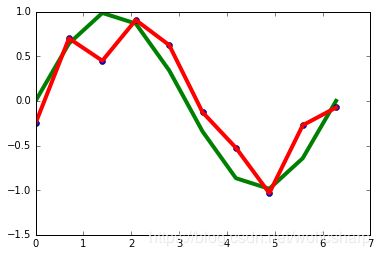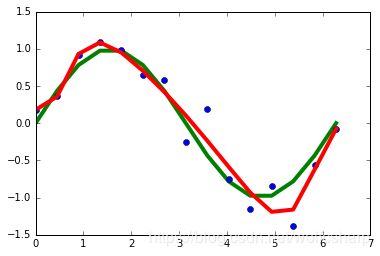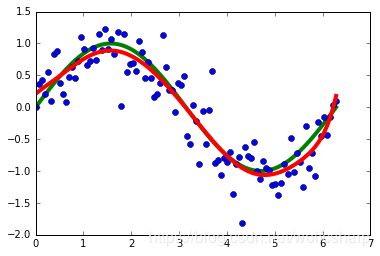- 零基础学人工智能:TensorFlow 入门例子
人工智能MOS
人工智能tensorflowpython
识别手写图片因为这个例子是TensorFlow官方的例子,不会说的太详细,会加入了一点个人的理解,因为TensorFlow提供了各种工具和库,帮助开发人员构建和训练基于神经网络的模型。TensorFlow中最重要的概念是张量(Tensor),它代表了多维数组或矩阵,因此TensorFlow支持各种不同类型的计算,如线性回归、逻辑回归、卷积神经网络、循环神经网络等。所以帮我们极大减少了对数学与算法基
- C++ 数学与算法系列之高斯消元法求解线性方程组
一枚大果壳
C++编程之美算法c++线性代数
1.前言什么是消元法?消元法是指将多个方程式组成的方程组中的若干个变量通过有限次地变换,消去方程式中的变量,通过简化方程式,从而获取结果的一种解题方法。消元法主要有代入消元法、加减消元法、整体消元法、换元消元法、构造消元法、因式分解消元法、常数消元法、利用比例性质消元法等。对方程式消元时,是基于如下的初等行变换规则:改变方程组中方程式的顺序,或者说无论先求解方程组中哪一个方程式,不影响方程组的解。
- C++ 数学与算法系列之牛顿、二分迭代法求解非线性方程
一枚大果壳
C++编程之美算法python
1.前言前文介绍了如何使用“高斯消元法”求解线性方程组。本文秉承有始有终的态度,继续介绍“非线性方程”的求解算法。本文将介绍2个非线性方程算法:牛顿迭代法。二分迭代法。牛顿迭代法(Newton'smethod)又称为牛顿-拉夫逊方法(Newton-Raphsonmethod),是拉夫逊和牛顿同时提出来的一种在实数域和复数域上近似求解方程的方法。为何说是近似求解方程?因为对于多数方程式,因不存在求根
- 【数学与算法】【分段三次Hermite插值】和【分段三次样条插值】
Mister Zhu
数学和算法插值
光滑曲线在数学上的定义是什么??原文链接:光滑曲线在数学上的定义是什么?回答1:定义:切线随切点的移动而连续转动。若函数f(x)f(x)f(x)在区间(a,b)(a,b)(a,b)内具有一阶连续导数,则其图形为一条处处有切线的曲线。则为光滑曲线。简言之,若f′(x)f'(x)f′(x)连续,则曲线光滑。但反之,不成立。比如圆,圆在直角坐标系下,有两条竖直的切线,导数不存在(为∞大)。回答2:不敢保
- 【数学与算法】跟踪、预测、单目标、多目标、匈牙利匹配之间的关系
Mister Zhu
数学和算法自动驾驶算法
关于多目标跟踪的文章可以参考目标跟踪初探——SORT。多目标跟踪的步骤先后(简单记法):先预测,再匈牙利匹配,最后再卡尔曼预测矫正,得到最优估计。【卡尔曼预测+匈牙利匹配】进行多目标跟踪的详细步骤:(1)根据预测方程,计算【状态预测值(先验值)】、【状态误差协方差先验估计】;(2)计算每个检测对象与每个状态跟踪器之间的【代价矩阵】;(3)匈牙利匹配(KM算法)求出【检测对象和跟踪器的匹配对】、【未
- 【数学与算法】PCA主成分分析与降维的通俗理解
Mister Zhu
数学和算法pca降维
1.PCA与降维PCA主成分分析简单的理解,就是把某物的很多个能直接获取到的特征,经过变换得到很多个新特征,所有的新特征就是该物的成分。这些新特征对该物体来说,有的影响很大,有的影响很小,只需要使用这些影响大的新特征,舍弃很多影响小的新特征,就是使用主要的一些成分来分析,舍弃不重要的成分,这就是主成分分析的方法。相当于把特征维度给降低了,所以也叫降维。2.举例例如,假如我们想要用新方法衡量一个学生
- 【数学与算法】非线性最小二乘法的解法【最速梯度下降法】、【牛顿法】、【高斯牛顿法】、【LM算法】
Mister Zhu
数学和算法算法最小二乘法人工智能
关于非线性优化的问题,可以推荐观看视觉SLAM十四讲视频的第六讲非线性优化。如果不明白线性和非线性,可参考这篇博客:线性最小二乘和非线性最小二乘这篇博客的后面有讲到几种优化方法(最速梯度下降法、牛顿法、高斯牛顿法,LM算法),很容易记住,不像其他的公式推导那么生硬:BundleAdjustment—即最小化重投影误差(高翔slam—第七讲)这篇博客也很棒非线性优化(高翔slam—第六讲)下图摘自非
- 【数学与算法】KMeans聚类代码
Mister Zhu
数学和算法聚类
KMeans聚类是根据各点距离聚类中心的距离来把所有点分类到不同类别的无监督算法。对于聚类,就是两点:1.分类所有样本点:遍历每个数据样本点,分别计算该样本点与K个聚类中心的距离,把该样本点的类别重新分类为距离最小的那一类。2.更新聚类中心:所有样本点都按第一步重新分类后,把各类别的点重新计算聚类中心(求平均值的方法),更新K个类别的聚类中心值。3.重复前面两步,直到聚类中心点更新幅度小于阈值,或
- 欧拉计划(project euler)最详细中文题解
metaquant
技术世界数学算法编程语言python
欧拉计划是一个在线解题网站,题目以各类数学问题为主,通常需要结合一定的数学与编程知识,写出适当的程序求解问题(详细介绍可以参见我的文章)。相比于力扣等刷题网站,欧拉计划上的题目有着更丰富的知识背景,在解答题目的过程中常能学习新的数学与算法知识,享受解题愉悦的同时也能颇有收获。在我的解题过程中,我尽量追求对每道题给出最优的解法,然后写文章把我的思路与代码记录下来。在每篇文章中,我首先将题目翻译成了中
- 编程新手导论
wangluozhangleilei
杂谈编程语言数据结构设计模式编译器算法
第二部分导论,这一部分主要是关于编程的导论,(要懂得一点思想具备一点常识)《设计,编码,,与软工》(编程与思想)这一章解释了三种思想,原语,抽象,组合,,和软件开发的二个重要过程,,软件工程的相关概念,是编程入门的关键(要懂得一点领域内的数学)《数学与算法》(编程与数学)计算机整个就是架构在数学上的,跟计算机平台实现,算法设计,,架构密切相关,,真正要深入编程,,,对数学的学习是必须的,,千万不要
- 有趣的算法(一):如何让有情人终成眷属
闻人翎悬
***算法与编程艺术***DataScience:统计学习有趣的算法
我的机器学习教程「美团」算法工程师带你入门机器学习以及「三分钟系列」数据结构与算法已经开始更新了,欢迎大家订阅~这篇专栏整合了这几年的算法知识,简单易懂,也将是我实体书的BLOG版。欢迎大家扫码关注微信公众号「图灵的猫」,除了有更多AI、算法、Python相关文章分享,还有免费的SSR节点和外网学习资料。其他平台(微信/知乎/B站)也是同名「图灵的猫」,不要迷路哦~数学与算法告诉我们,有情人必将终
- 老猪带你玩转自定义控件三——sai大神带我实现ios 8 时间滚轮控件
weixin_34302561
ios8的时间滚轮控件实现了扁平化,带来很好用户体验,android没有现成控件,小弟不才,数学与算法知识不过关,顾十分苦恼,幸好在github上找到sai大神实现代码,甚为欣喜,顾把学习这个控件点滴记录下来,分享给大家。项目原地址https://github.com/saiwu-bigkoo/Android-PickerView。ios8滚轮的效果:而sai大神控件的效果:哎,妈呀是不是效果95
- Android 实现 ios 滚轮效果
qq_26972449
Android基础学习——其它
转载自:博客园网址:http://www.cnblogs.com博客原文:http://www.cnblogs.com/manuosex/p/5032934.htmlios8的时间滚轮控件实现了扁平化,带来很好用户体验,android没有现成控件,小弟不才,数学与算法知识不过关,顾十分苦恼,幸好在github上找到sai大神实现代码,甚为欣喜,顾把学习这个控件点滴记录下来,分享给大家。项目原地址h
- Python趣味编程:从入门到人工智能 高清完整版免费下载Python基础教程免费电子书
Spade_King
点击获取书籍提取码:ija8内容简介本书是专门为青少年编写的零基础Python语言>编程人门教材,由浅人深、循序渐进地讲授Python语言编程知识,以解决问题为导向,培养青少年的编程思维。本书采用单元课程的形式编排内容,分为编程基础、数学与算法、游戏编程、人工智能四个单元,采用符合青少年认知水平的趣味案例进行教学,指导青少年使用编程的思维方式解决身边的问题,带领青少年迈进Python编程的奇妙世界
- 数学与算法的艺术
ACdreamers
基础数学
为了更好体现数学在计算机算法中的重要作用,我来介绍一些数学知识以及它们的应用。Contens1.秦九韶算法9.最小二乘法2.斯特林公式10.自守数3.外观数列4.整数拆分问题5.阿贝尔变换6.二项式反演7.马青公式8.艾森斯坦判别法1.秦九韶算法秦九韶算法是中国南宋时期数学家秦九韶提出的一种计算多项式的优化算法。在西方又被称为Horner算法。给定一个多项式,计算这个多项式的值。可以对这个多项式进
- 不明觉厉!Gitee大神们的算法/数学相关开源项目推荐
Gitee
GiteeGitee项目推荐算法数学开源项目
现在的大厂面试,算法似乎已经成为了必考项目。当大家的业务水平相近,谁的数学与算法基础更好,谁可能就会获得更好的机会。Gitee上也有一些数学算法的大牛,今天就为大家分享他们的开源项目,希望能给正在学习算法和数学的你有所帮助。1.mfcplot项目作者:rewine开源许可协议:MIT项目地址:https://gitee.com/rewine/mfcplotmfc数学函数曲线绘制程序。2.milvu
- 组合数学与算法题-排列组合篇
rosewind
前言之前刷过一些leetcode的题目,这学期修了组合数学这门课,让我感受颇多。课程上更关注的是数学上的解法,并没有讲到具体的用某种语言实现,并没有深入地讲为什么这样做就是对的。结合我的经验,想分享一下我的理解。leetcode31.下一个全排列31.下一个全排列2个关键点:下一个全排列比当前的大(字典序)增量要是最小的一些例子:1243->1324,要使1243更大,从右往左看,43已经是最大的
- python实现决策树实例
Realmhang
python机器学习
今天用python实现了一个决策树模型,python做机器学习有大量的库支持,简洁高效,没有深厚数学与算法基础的人也可以调用库来实现机器学习模型。当然大家想做好机器学习还是要好好积淀深厚的知识,只当调包侠能做的东西非常有限啊。本文是对经典的鸢尾花数据集做分类,大家需要下载sklearn、pandas、matplotlib、seaborn库,可以直接在pycharm中下载,另外鸢尾花数据集已经包含在
- 编程新手导论(转载)
扇子
第二部分导论,这一部分主要是关于编程的导论,(要懂得一点思想具备一点常识)《设计,编码,,与软工》(编程与思想)这一章解释了三种思想,原语,抽象,组合,,和软件开发的二个重要过程,,软件工程的相关概念,是编程入门的关键(要懂得一点领域内的数学)《数学与算法》(编程与数学)计算机整个就是架构在数学上的,跟计算机平台实现,算法设计,,架构密切相关,,真正要深入编程,,,对数学的学习是必须的,,千万不要
- 编程新手导论(转载)
叶广明_微信ye_guangming
面试编程语言数据结构设计模式编译器算法
第二部分导论,这一部分主要是关于编程的导论,(要懂得一点思想具备一点常识)《设计,编码,,与软工》(编程与思想)这一章解释了三种思想,原语,抽象,组合,,和软件开发的二个重要过程,,软件工程的相关概念,是编程入门的关键(要懂得一点领域内的数学)《数学与算法》(编程与数学)计算机整个就是架构在数学上的,跟计算机平台实现,算法设计,,架构密切相关,,真正要深入编程,,,对数学的学习是必须的,,千万不要
- Java 技术书籍大全
济南市民刘先生
java
前言本文档目前已收录277本Java相关领域经典技术书籍,从初级开发者到资深架构师,涵盖Java从业者的各个阶段。涵盖领域:Java入门书籍,Java基础及进阶书籍,框架与中间件,架构设计,设计模式,数学与算法,JVM周边语言,项目管理&领导力&流程,职业素养与个人成长,格局与视野,面试参考书等。入门书籍《明解Java》-豆瓣评分8.5《Java从入门到精通(第4版附光盘)》-豆瓣评分6《入门很简
- "歌美"之游戏开发之数学与算法_中级篇
小太阳会发光诺
ActionScript3.0是一种强大的面向对象编程语言,它还是一种适合快速构建效果丰富的互联网应用程序的语言,它所构建的应用程序已经成为Web体验的重要部分。本书以ActionScript为核心,辅以Photoshop等作为工具,深入剖析了图形图像算法及特性,介绍了游戏等特效的制作和实现,并且聚焦相关技术在交互程序各领域的应用。课程目录:课时1:概率问题与三角函数(1)课时2:概率问题与三角函
- "歌美"之游戏开发之数学与算法_高级篇
小太阳会发光诺
ActionScript3.0是一种强大的面向对象编程语言,它还是一种适合快速构建效果丰富的互联网应用程序的语言,它所构建的应用程序已经成为Web体验的重要部分。本书以ActionScript为核心,辅以Photoshop等作为工具,深入剖析了图形图像算法及特性,介绍了游戏等特效的制作和实现,并且聚焦相关技术在交互程序各领域的应用。课程目录:第1章:换元积分法和贝塞尔曲线积分的拟合课时1:换元积分
- 从入门到入坟:Java程序员一生要看多少书?Java技术书籍大全来啦
Java技术箭
Java程序员SpringBoot
本文档目前已收录277本Java相关领域经典技术书籍,从初级开发者到资深架构师,涵盖Java从业者的各个阶段,并持续更新。涵盖领域:Java入门书籍,Java基础及进阶书籍,框架与中间件,架构设计,设计模式,数学与算法,JVM周边语言,项目管理&领导力&流程,职业素养与个人成长,格局与视野,面试参考书等。注:本文只是推荐,只有一小部分的书籍有文档资料分享。包括:【Redis实战】【Kafka核心设
- Java 技术书籍大全
乐百氏vic
Java技术书籍大全本文档目前已收录277本Java相关领域经典技术书籍,从初级开发者到资深架构师,涵盖Java从业者的各个阶段。涵盖领域:Java入门书籍,Java基础及进阶书籍,框架与中间件,架构设计,设计模式,数学与算法,JVM周边语言,项目管理&领导力&流程,职业素养与个人成长,格局与视野,面试参考书等。入门书籍《明解Java》-豆瓣评分8.5《Java从入门到精通(第4版附光盘)》-豆瓣
- 80后博导拟任“211大学”副校长 曾是人大最年轻教授
机器学习算法与Python学习-公众号
本文转自“数学与算法之美”2012年,时年32岁的他成为中国人民大学最年轻的教授。6月20日,海南省委组织部发布干部任前公示,其中,现任中国人民大学汉青经济与金融高级研究院教授、反垄断与竞争政策研究所所长叶光亮拟任海南大学党委常委、副校长(试用期一年)。叶光亮温州新闻网图据公开简历,叶光亮是一名“80后”学者,生于1980年4月,研究生学历,经济学博士学位,教授,博士生导师,长江学者(青年)。叶光
- 数学与算法的艺术
K_ona
数学
为了更好体现数学在计算机算法中的重要作用,我来介绍一些数学知识以及它们的应用。转自:https://blog.csdn.net/acdreamersContens1.秦九韶算法9.最小二乘法2.斯特林公式10.自守数3.外观数列4.整数拆分问题5.阿贝尔变换6.二项式反演7.马青公式8.艾森斯坦判别法1.秦九韶算法秦九韶算法是中国南宋时期数学家秦九韶提出的一种计算多项式的优化算法。在西方又被称为H
- 老猪带你玩转自定义控件三——sai大神带我实现ios 8 时间滚轮控件
laozhu1124
ios8的时间滚轮控件实现了扁平化,带来很好用户体验,android没有现成控件,小弟不才,数学与算法知识不过关,顾十分苦恼,幸好在github上找到sai大神实现代码,甚为欣喜,顾把学习这个控件点滴记录下来,分享给大家。项目原地址https://github.com/saiwu-bigkoo/Android-PickerView。ios8滚轮的效果: 而sai大神控件的效果: 哎,妈呀是不是效果
- 数学与算法的艺术
ACdreamers
为了更好体现数学在计算机算法中的重要作用,我来介绍一些数学知识以及它们的应用。这将是一次很长的知识旅行。 Contens 1.秦九韶算法 9. 最小二乘法 2.斯特林公式 10.自守数 3.外观数列 4.整数拆分问题 5.阿贝尔变换 6.二项式反演 7.马青公式 8.艾森斯坦判别法 1.秦九韶算法
- 编程新手导论
设计模式数据结构编程算法语言编译器
第二部分导论,这一部分主要是关于编程的导论,(要懂得一点思想具备一点常识)《设计,编码,,与软工》(编程与思想)这一章解释了三种思想,原语,抽象,组合,,和软件开发的二个重要过程,,软件工程的相关概念,是编程入门的关键(要懂得一点领域内的数学)《数学与算法》(编程与数学)计算机整个就是架构在数学上的,跟计算机平台实现,算法设计,,架构密切相关,,真正要深入编程,,,对数学的学习是必须的,,千万不要
- jQuery 键盘事件keydown ,keypress ,keyup介绍
107x
jsjquerykeydownkeypresskeyup
本文章总结了下些关于jQuery 键盘事件keydown ,keypress ,keyup介绍,有需要了解的朋友可参考。
一、首先需要知道的是: 1、keydown() keydown事件会在键盘按下时触发. 2、keyup() 代码如下 复制代码
$('input').keyup(funciton(){
- AngularJS中的Promise
bijian1013
JavaScriptAngularJSPromise
一.Promise
Promise是一个接口,它用来处理的对象具有这样的特点:在未来某一时刻(主要是异步调用)会从服务端返回或者被填充属性。其核心是,promise是一个带有then()函数的对象。
为了展示它的优点,下面来看一个例子,其中需要获取用户当前的配置文件:
var cu
- c++ 用数组实现栈类
CrazyMizzz
数据结构C++
#include<iostream>
#include<cassert>
using namespace std;
template<class T, int SIZE = 50>
class Stack{
private:
T list[SIZE];//数组存放栈的元素
int top;//栈顶位置
public:
Stack(
- java和c语言的雷同
麦田的设计者
java递归scaner
软件启动时的初始化代码,加载用户信息2015年5月27号
从头学java二
1、语言的三种基本结构:顺序、选择、循环。废话不多说,需要指出一下几点:
a、return语句的功能除了作为函数返回值以外,还起到结束本函数的功能,return后的语句
不会再继续执行。
b、for循环相比于whi
- LINUX环境并发服务器的三种实现模型
被触发
linux
服务器设计技术有很多,按使用的协议来分有TCP服务器和UDP服务器。按处理方式来分有循环服务器和并发服务器。
1 循环服务器与并发服务器模型
在网络程序里面,一般来说都是许多客户对应一个服务器,为了处理客户的请求,对服务端的程序就提出了特殊的要求。
目前最常用的服务器模型有:
·循环服务器:服务器在同一时刻只能响应一个客户端的请求
·并发服务器:服
- Oracle数据库查询指令
肆无忌惮_
oracle数据库
20140920
单表查询
-- 查询************************************************************************************************************
-- 使用scott用户登录
-- 查看emp表
desc emp
- ext右下角浮动窗口
知了ing
JavaScriptext
第一种
<!DOCTYPE html PUBLIC "-//W3C//DTD XHTML 1.0 Transitional//EN" "http://www.w3.org/TR/xhtml1/DTD/xhtml1-transitional.dtd">
<html xmlns="http://www.w3.org/1999/
- 浅谈REDIS数据库的键值设计
矮蛋蛋
redis
http://www.cnblogs.com/aidandan/
原文地址:http://www.hoterran.info/redis_kv_design
丰富的数据结构使得redis的设计非常的有趣。不像关系型数据库那样,DEV和DBA需要深度沟通,review每行sql语句,也不像memcached那样,不需要DBA的参与。redis的DBA需要熟悉数据结构,并能了解使用场景。
- maven编译可执行jar包
alleni123
maven
http://stackoverflow.com/questions/574594/how-can-i-create-an-executable-jar-with-dependencies-using-maven
<build>
<plugins>
<plugin>
<artifactId>maven-asse
- 人力资源在现代企业中的作用
百合不是茶
HR 企业管理
//人力资源在在企业中的作用人力资源为什么会存在,人力资源究竟是干什么的 人力资源管理是对管理模式一次大的创新,人力资源兴起的原因有以下点: 工业时代的国际化竞争,现代市场的风险管控等等。所以人力资源 在现代经济竞争中的优势明显的存在,人力资源在集团类公司中存在着 明显的优势(鸿海集团),有一次笔者亲自去体验过红海集团的招聘,只 知道人力资源是管理企业招聘的 当时我被招聘上了,当时给我们培训 的人
- Linux自启动设置详解
bijian1013
linux
linux有自己一套完整的启动体系,抓住了linux启动的脉络,linux的启动过程将不再神秘。
阅读之前建议先看一下附图。
本文中假设inittab中设置的init tree为:
/etc/rc.d/rc0.d
/etc/rc.d/rc1.d
/etc/rc.d/rc2.d
/etc/rc.d/rc3.d
/etc/rc.d/rc4.d
/etc/rc.d/rc5.d
/etc
- Spring Aop Schema实现
bijian1013
javaspringAOP
本例使用的是Spring2.5
1.Aop配置文件spring-aop.xml
<?xml version="1.0" encoding="UTF-8"?>
<beans
xmlns="http://www.springframework.org/schema/beans"
xmln
- 【Gson七】Gson预定义类型适配器
bit1129
gson
Gson提供了丰富的预定义类型适配器,在对象和JSON串之间进行序列化和反序列化时,指定对象和字符串之间的转换方式,
DateTypeAdapter
public final class DateTypeAdapter extends TypeAdapter<Date> {
public static final TypeAdapterFacto
- 【Spark八十八】Spark Streaming累加器操作(updateStateByKey)
bit1129
update
在实时计算的实际应用中,有时除了需要关心一个时间间隔内的数据,有时还可能会对整个实时计算的所有时间间隔内产生的相关数据进行统计。
比如: 对Nginx的access.log实时监控请求404时,有时除了需要统计某个时间间隔内出现的次数,有时还需要统计一整天出现了多少次404,也就是说404监控横跨多个时间间隔。
Spark Streaming的解决方案是累加器,工作原理是,定义
- linux系统下通过shell脚本快速找到哪个进程在写文件
ronin47
一个文件正在被进程写 我想查看这个进程 文件一直在增大 找不到谁在写 使用lsof也没找到
这个问题挺有普遍性的,解决方法应该很多,这里我给大家提个比较直观的方法。
linux下每个文件都会在某个块设备上存放,当然也都有相应的inode, 那么透过vfs.write我们就可以知道谁在不停的写入特定的设备上的inode。
幸运的是systemtap的安装包里带了inodewatch.stp,位
- java-两种方法求第一个最长的可重复子串
bylijinnan
java算法
import java.util.Arrays;
import java.util.Collections;
import java.util.List;
public class MaxPrefix {
public static void main(String[] args) {
String str="abbdabcdabcx";
- Netty源码学习-ServerBootstrap启动及事件处理过程
bylijinnan
javanetty
Netty是采用了Reactor模式的多线程版本,建议先看下面这篇文章了解一下Reactor模式:
http://bylijinnan.iteye.com/blog/1992325
Netty的启动及事件处理的流程,基本上是按照上面这篇文章来走的
文章里面提到的操作,每一步都能在Netty里面找到对应的代码
其中Reactor里面的Acceptor就对应Netty的ServerBo
- servelt filter listener 的生命周期
cngolon
filterlistenerservelt生命周期
1. servlet 当第一次请求一个servlet资源时,servlet容器创建这个servlet实例,并调用他的 init(ServletConfig config)做一些初始化的工作,然后调用它的service方法处理请求。当第二次请求这个servlet资源时,servlet容器就不在创建实例,而是直接调用它的service方法处理请求,也就是说
- jmpopups获取input元素值
ctrain
JavaScript
jmpopups 获取弹出层form表单
首先,我有一个div,里面包含了一个表单,默认是隐藏的,使用jmpopups时,会弹出这个隐藏的div,其实jmpopups是将我们的代码生成一份拷贝。
当我直接获取这个form表单中的文本框时,使用方法:$('#form input[name=test1]').val();这样是获取不到的。
我们必须到jmpopups生成的代码中去查找这个值,$(
- vi查找替换命令详解
daizj
linux正则表达式替换查找vim
一、查找
查找命令
/pattern<Enter> :向下查找pattern匹配字符串
?pattern<Enter>:向上查找pattern匹配字符串
使用了查找命令之后,使用如下两个键快速查找:
n:按照同一方向继续查找
N:按照反方向查找
字符串匹配
pattern是需要匹配的字符串,例如:
1: /abc<En
- 对网站中的js,css文件进行打包
dcj3sjt126com
PHP打包
一,为什么要用smarty进行打包
apache中也有给js,css这样的静态文件进行打包压缩的模块,但是本文所说的不是以这种方式进行的打包,而是和smarty结合的方式来把网站中的js,css文件进行打包。
为什么要进行打包呢,主要目的是为了合理的管理自己的代码 。现在有好多网站,你查看一下网站的源码的话,你会发现网站的头部有大量的JS文件和CSS文件,网站的尾部也有可能有大量的J
- php Yii: 出现undefined offset 或者 undefined index解决方案
dcj3sjt126com
undefined
在开发Yii 时,在程序中定义了如下方式:
if($this->menuoption[2] === 'test'),那么在运行程序时会报:undefined offset:2,这样的错误主要是由于php.ini 里的错误等级太高了,在windows下错误等级
- linux 文件格式(1) sed工具
eksliang
linuxlinux sed工具sed工具linux sed详解
转载请出自出处:
http://eksliang.iteye.com/blog/2106082
简介
sed 是一种在线编辑器,它一次处理一行内容。处理时,把当前处理的行存储在临时缓冲区中,称为“模式空间”(pattern space),接着用sed命令处理缓冲区中的内容,处理完成后,把缓冲区的内容送往屏幕。接着处理下一行,这样不断重复,直到文件末尾
- Android应用程序获取系统权限
gqdy365
android
引用
如何使Android应用程序获取系统权限
第一个方法简单点,不过需要在Android系统源码的环境下用make来编译:
1. 在应用程序的AndroidManifest.xml中的manifest节点
- HoverTree开发日志之验证码
hvt
.netC#asp.nethovertreewebform
HoverTree是一个ASP.NET的开源CMS,目前包含文章系统,图库和留言板功能。代码完全开放,文章内容页生成了静态的HTM页面,留言板提供留言审核功能,文章可以发布HTML源代码,图片上传同时生成高品质缩略图。推出之后得到许多网友的支持,再此表示感谢!留言板不断收到许多有益留言,但同时也有不少广告,因此决定在提交留言页面增加验证码功能。ASP.NET验证码在网上找,如果不是很多,就是特别多
- JSON API:用 JSON 构建 API 的标准指南中文版
justjavac
json
译文地址:https://github.com/justjavac/json-api-zh_CN
如果你和你的团队曾经争论过使用什么方式构建合理 JSON 响应格式, 那么 JSON API 就是你的 anti-bikeshedding 武器。
通过遵循共同的约定,可以提高开发效率,利用更普遍的工具,可以是你更加专注于开发重点:你的程序。
基于 JSON API 的客户端还能够充分利用缓存,
- 数据结构随记_2
lx.asymmetric
数据结构笔记
第三章 栈与队列
一.简答题
1. 在一个循环队列中,队首指针指向队首元素的 前一个 位置。
2.在具有n个单元的循环队列中,队满时共有 n-1 个元素。
3. 向栈中压入元素的操作是先 移动栈顶指针&n
- Linux下的监控工具dstat
网络接口
linux
1) 工具说明dstat是一个用来替换 vmstat,iostat netstat,nfsstat和ifstat这些命令的工具, 是一个全能系统信息统计工具. 与sysstat相比, dstat拥有一个彩色的界面, 在手动观察性能状况时, 数据比较显眼容易观察; 而且dstat支持即时刷新, 譬如输入dstat 3, 即每三秒收集一次, 但最新的数据都会每秒刷新显示. 和sysstat相同的是,
- C 语言初级入门--二维数组和指针
1140566087
二维数组c/c++指针
/*
二维数组的定义和二维数组元素的引用
二维数组的定义:
当数组中的每个元素带有两个下标时,称这样的数组为二维数组;
(逻辑上把数组看成一个具有行和列的表格或一个矩阵);
语法:
类型名 数组名[常量表达式1][常量表达式2]
二维数组的引用:
引用二维数组元素时必须带有两个下标,引用形式如下:
例如:
int a[3][4]; 引用:
- 10点睛Spring4.1-Application Event
wiselyman
application
10.1 Application Event
Spring使用Application Event给bean之间的消息通讯提供了手段
应按照如下部分实现bean之间的消息通讯
继承ApplicationEvent类实现自己的事件
实现继承ApplicationListener接口实现监听事件
使用ApplicationContext发布消息
 问题描述:给定一些数据点,用一个多项式尽可能好的拟合出这些点排布的轨迹,并给出解析解
问题描述:给定一些数据点,用一个多项式尽可能好的拟合出这些点排布的轨迹,并给出解析解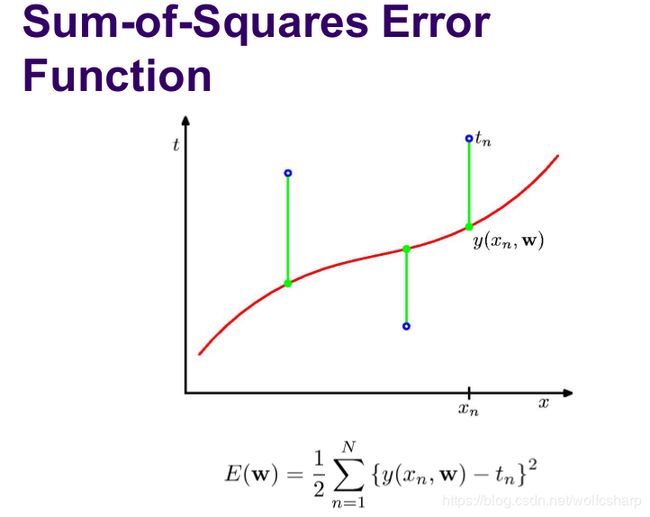 然后计算均方根误差:
然后计算均方根误差: 多项式拟合问题本质是一个优化问题,目标函数是使RMS误差最小。
多项式拟合问题本质是一个优化问题,目标函数是使RMS误差最小。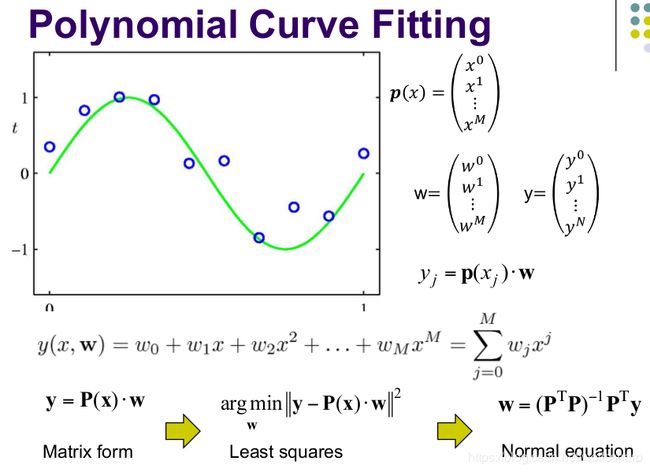 最小二乘法推导:RMS误差与E(W)成正比,E(W)最优等价于RMS最优
最小二乘法推导:RMS误差与E(W)成正比,E(W)最优等价于RMS最优

![]()



